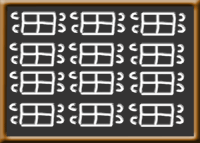Olha Madylus offers three suggestions for classroom layouts for young learner and teen classes, with advantages and disadvantages for using each.
Classroom set-up A: Desks individually in rows facing the front
|
|
| KEY |
|
|
| = desk and student |
In this setup, there is very little room for children to get up or for the teacher to move around the class, and students must work on their own. The class is dominated by the teacher (who works very hard) and students are very passive and probably restless too.
Classrooms may be set up like this to ensure quiet and control. If you are concerned that your students will be noisy or silly when desks are moved, explain why you want them to sit closer and expect some surprise. However, children usually respond well when they know what is expected of them and when they can understand and experience the benefits of new approaches. Children will respond negatively when they feel insecure, so tell them what they are doing and why.
Without much movement, however, it is possible to get children to work in pairs or groups to encourage communication and make activities more fun.
Classroom set-up B: Desks in pairs
|
|
By putting two desks together, students can easily work together, sharing ideas and peer teaching. This is very useful when your students are mixed ability as stronger ones can help those with problems. If students are asked to complete an exercise from the course book, by working together they can help explain what they think the correct answers are and share ideas about the language. This approach means that they will have more chance of success and the teacher can spend time monitoring and helping students rather than trying to help all those with problems or keeping them quiet.
Here are some more ideas for activities in this set-up:
-
Dialogue reading
Many course books introduce language items with dialogues that children either read or listen to. To give children practice in producing oral English and to help them remember the new language, students can read the dialogues together, taking a part each. Encourage them to think about the meaning of the words and to put realistic intonation into their reading. This may seem noisy, but your students will be maximising their practice of English. To avoid purely mechanical reading (children not thinking about the meaning of what they say) get students to change the words so they are more relevant to them or to the country they are in. -
Writing
This is a difficult skill. When children work together to produce a piece of text, they have the chance to try out structures and vocabulary and tend to draft (rewrite and improve) much more than when they write on their own. It is also more fun working with another student and easier to sustain energy and interest in the task. Below is an example activity:- Students have been learning vocabulary to describe people. Choose a character appropriate for the age of your students like an alien, a robber, a superhero or a corrupt politician.
- First, ask the students to shut their eyes and imagine this character.
- Then they tell each other what this character looked like in their mind’s eye.
- Next they decide on how they want the character they are going to write about to look. They could draw a picture first.
- After this they write a list of all the main characteristics, e.g. kind eyes, a long scar on the right cheek, blue skin.
- Once they have plenty of ideas, they must write a descriptive paragraph together (the length depends on the age and ability of the children). While they write they must try to be as descriptive and interesting as possible. They can make as many changes as they want while writing.
- Once they are happy that they have got a really good description they can write it up neatly. You will notice that a text written in this way is invariably more accurate, descriptive and richer than one written by a student on their own.
-
Pair
Students of all ages all like doing picture dictations, which are very easy to set up and get lots of language practised. First the teacher describes a picture and students must draw what they hear. For example, it could be to practise describing people (He is very tall, he has large round eyes and a square shaped nose …) or for prepositions of place (There is a house on top of a mountain. An airplane is flying over the house, an elephant is standing in front on the house …).
Get students to draw their own pictures without showing them to their partners and then take turns describing their picture to their partner, who must draw the picture. They check each others’ dictations by comparing the pictures. Students tend not to go back to mother tongue if they have been well prepared with sufficient vocabulary to do this task.
Classroom set-up C: Desks in groups of four facing each other, sideways on to the board
|
|
By moving four desks together, students can interact with each other but can still easily turn their heads to face the board and teacher. Here are some ideas for activities in this set-up:
-
Brainstorming
Before reading or writing about a particular topic, e.g. transport, get the students in their groups to think up all the words and/or ideas they know and write them onto one piece of paper (cars, trains, dangerous drivers, petrol, pollution, I like riding my bicycle, etc). This helps to prepare them for the coming activity: they have predicted words they may be reading or come up with ideas and lexis they can use in their writing, and very importantly they are able to see what they already know and teach each other words they have in their personal lexicons. It also allows for some time in the lesson that is relaxed and not teacher-centered. -
Discussion
This is also good before students read or write about a topic. It can also be used to recycle language previously encountered by students and may be a nice way to finish a lesson. Either write a statement on the board or dictate it to the students and give them a time limit (especially if you are worried about noise levels or spending too much time away from the book) to discuss their ideas about the statement.
e.g. Children spend too much time watching television.
Students have an opportunity to exchange ideas and practise their English in a relatively unstructured but meaningful way. -
Problem
Teenagers enjoy the challenge of such activities.For example, dictate the following list: a box of matches, a ball of string, a knife, a radio, enough tinned food for three days, aspirins, a hammer and nails, a warm coat, a picture of your family and a gun. Put students into groups and explain that they have been shipwrecked and are on a desert island. There is fresh water on this island, trees and probably dangerous wild animals. They must decide together which THREE of the articles on the list they would choose to have with them and be ready to explain why.
This kind of activity makes them think, and many teenagers like the challenge. It also encourages exchange of ideas (encourage the use of expressions like ‘What do you think?’) and variety of vocabulary and structures. -
Role play
Children of all ages like role plays. They can be used to recycle and consolidate previously learnt language and to practise real life communications in English. For example, if the class has been studying food vocabulary in their course book, the groups could role play a visit to a local restaurant, with one student being the waiter and the other three a family visiting the restaurant. Students could design the menus before the role play.
For older students it can be valuable for them to role play family situations where there is tension between adults and teens. While in the role of parents or teachers, they are forced to see a situation from the other person’s perspective. They can also have a lot of fun.
Classroom management

Articles and studies featuring classroom-management methodologies with practical tips and advice on approaching problems such as discipline, large and mixed ability classes, classroom structure and error correction.
- 1
- 2
- 3
- 4
- 5
- 6
- 7
- 8
 Currently
reading
Currently
reading
Classroom management: Classroom layout
- 10
- 11
- 12


















No comments yet